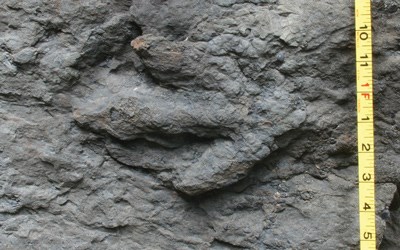
NPS Photos 
Identification level: various
Trace fossils are classified based on an organism’s shape and behaviors rather than on its physical form. Some of the trace fossils found in Denali have been linked to body fossils from similar-aged rocks on the North Slope or Talkeetna Mountains. These linkages provide scientists with more definitive identities than are known from trace fossils alone. “Walking with Dinosaurs” is easy to imagine in Denali. There are so many dinosaur footprints in some areas that they have been nicknamed “dinosaur dance floors”. These tracks help scientists determine which animals were present, how many might have traveled together, and the ages of different individuals (such as mother with young). In addition, tail dragging marks have been found that illustrate an animal’s body position when walking. What is for dinner?
Trace fossils help to give us a seat at the ancient dinner table. Probe marks in the ground near bird tracks imply that the birds were using their beaks to dig for food. Invertebrate burrows found in the same rocks likely provide the answer to what tasty food the birds were eating. Coprolites, fossilized feces, can be compared to modern scat to suggest the diet of ancient animals. 
NPS Photo During a geology field camp in 2005, Dr. Paul McCarthy from the University of Alaska Fairbanks Department of Geology and Geophysics rested his hand on an outcrop of the Cantwell Formation and spoke to a small group of students about how similar-aged rocks commonly preserve dinosaur tracks in other places. When he suggested that the group should keep an eye out for fossils, student Susi Tomsich pointed near the professor’s hand and asked, “Like that one?” That original theropod track is now on display at the Murie Science and Learning Center in Denali. How do I look? Some Denali trace fossils preserve something very unique…skin impressions. The impressions are usually found within a footprint or other body impression. The skin leaves a well-organized, repeating pattern in the rock that may appear wrinkly or scaly. These fossils help illuminate what the dinosaurs may have looked like. Fun fact
Body fossils (fossilized bones, for instance) preserve records from the moment of an organism’s death. Trace fossils, on the other hand, are evidence of life in the past and give a glimpse into everyday activities such as walking, crawling, burrowing, and feeding. |
Last updated: August 18, 2016
